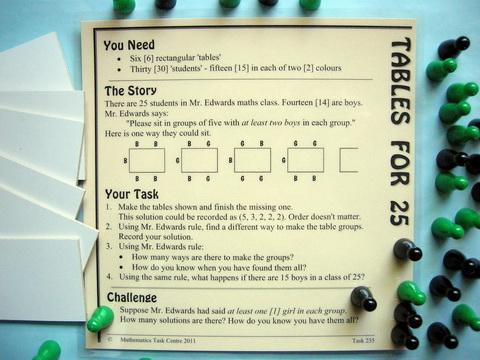
Tables for 25Task 235 ... Years 4 - 8SummaryThe story shell is familiar to students - the teacher says that he wants them to sit in certain size groups. But then he adds a condition - at least two boys in each group. Now we have the interesting problem of working out all the possible table arrangements for a class with a given number of boys and a given total number of students. A problem is always more interesting if it has more than one answer, and this one does. To find them all the problem has to be broken into parts and the strategy of try every possible case has to be applied. Then comes the What happens if...? questions and the possibility for each pair to investigate their own 'Tables For' problem. |
Materials
Content
|

IcebergA task is the tip of a learning iceberg. There is always more to a task than is recorded on the card. |
Mr. Edwards really did invent this task. His initial problem concerned his class of 25 with 14 boys. The missing table in the picture must have three boys and two girls and the complete solution could be recorded as (5, 3, 2, 2, 2) because only the boys need to be recorded. The number of girls is the complementary addition to 5 in each group and to 25 for the class. Students usually realise early on that the 2 boys who must be at every table should be placed first. The other boys are can be placed anywhere after that. The reasoning goes something like this:
If we consider a class size of 24 for example, the class could sit in groups of 2, 3, 4, 5, 6, 8. Then the number of girls in the class could be ... and the 'at least' statement could be ... well, for each group size what's the smallest it could be? ... the largest? ... how many arrangements for the highest and the lowest and how many for each of the numbers between. Now that's a serious investigation. But suppose the class is 23 students. Then the class could sit in groups of ... 1 or 23. Then the number of boys in the class could be... well it doesn't matter much, because there really isn't much that can be asked. So what's different about the numbers 24 and 23?
|
Whole Class InvestigationTasks are an invitation for two students to work like a mathematician. Tasks can also be modified to become whole class investigations which model how a mathematician works. |
It seems appropriate to begin the lesson by using your own class, if it is the right number. That number can be any non-prime number. If your class is a prime number select the appropriate number of non-participating students to be your monitors. They can count for you and record details on the whiteboard. Once the students have the idea of how the problem works, introduce your friend Mr. Edwards who tried it in his class of 25 with 14 boys. What size groups would he ask for?
For more ideas and discussion about this investigation, open a new browser tab (or page) and visit Maths300 Lesson 178, Tables For 25, which also includes a sample Assessment Project. Visit Tables For 25 on Poly Plug & Tasks. |
Is it in Maths With Attitude?Maths With Attitude is a set of hands-on learning kits available from Years 3-10 which structure the use of tasks and whole class investigations into a week by week planner. |
Tables For 25 is not in any MWA kit. However it can be used to enrich the Number & Computation kits at Years 3/4 and Years 7/8. |